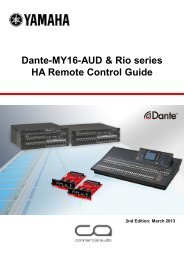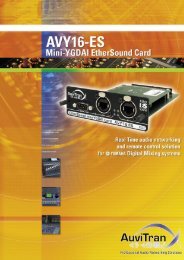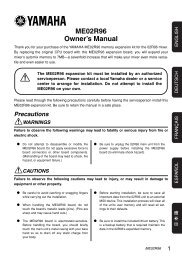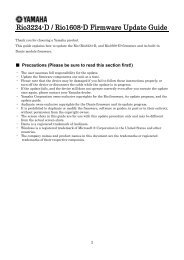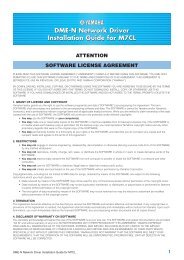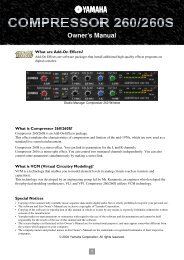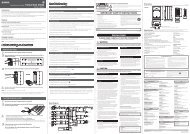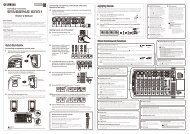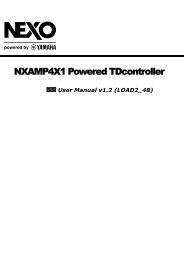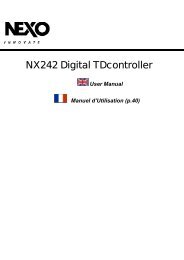Yamaha Digital Audio System Design Guide 8.42MB
Yamaha Digital Audio System Design Guide 8.42MB
Yamaha Digital Audio System Design Guide 8.42MB
You also want an ePaper? Increase the reach of your titles
YUMPU automatically turns print PDFs into web optimized ePapers that Google loves.
15<br />
EtherSound EtherSound<br />
AVS-ESMonitor<br />
HA Remote Settings for NAI48-ES and <strong>Digital</strong> Mixer<br />
In order that HA Remote signals can be relayed to AD8HRs (AD converters supporting remote head-amp control) connected to an NAI48-ES,<br />
settings must be made for the mixer’s ES card and the NAI48-ES. Furthermore, it will be necessary to use a PC running AVS-ESMonitor to do<br />
so.<br />
Setting procedure<br />
1 With the network already having been correctly confi gured, launch AVS-ESMonitor and confi rm that all connected devices are detected<br />
and correctly recognized.<br />
2 In order to enable communication between a digital mixer fi tted with an MY16-ES64 card and an NAI48-ES, settings for the NAI48-ES<br />
are performed fi rst, followed by settings for the MY16-ES64. To begin, select the NAI48-ES from the list displayed in AVS-ESMonitor, and<br />
then display the Control tab. Within the Serial Communication Mode area, turn on the Unicast radio button, and from the drop-down list<br />
on the right, select the card with which signals are to be exchanged.<br />
3 The next step is to setup the card. In the same way as above, select the MY16-ES64 from the list displayed in AVS-ESMonitor, and then<br />
display the Control tab. Within the AD8HR Remote Option area, select Mode 2 if controlling from an LS9 <strong>Digital</strong> Mixing Console or Mode<br />
3 if controlling from a PM5D V2 or M7CL <strong>Digital</strong> Mixing Console or from a DM1000 VCM or DM2000 VCM <strong>Digital</strong> Production Console.<br />
4 Finally, these settings must be stored in the internal memory of the connected devices. To do so, click the Save icon located in the AVS-<br />
ESMonitor tool bar. Successful writing to memory will be confi rmed by an on-screen message.<br />
<strong>Yamaha</strong> <strong>Digital</strong> <strong>Audio</strong> <strong>System</strong> <strong>Design</strong><br />
Stores settings within all of the connected devices<br />
Stores settings within the currently selected device only<br />
After setting up EtherSound equipments, the settings should be saved onto the hardware. If the power of the equipment is turned off without<br />
them being saved, the equipments will be reset to the last settings confi gured by AVS-ES Monitor.<br />
Mid-size Live SR<br />
In this case study, EtherSound is used to realize a sound-reinforcement solution for a mid-sized concert requiring 32-in / 16-out channels. In<br />
consideration of the distance from the M7CL-32 <strong>Digital</strong> Mixing Console, MY16-ES64 EtherSound Interface Card, and MY16-EX I/O Expansion<br />
Card, which are located within the audience area, Cat5 cables are used to connect with the on-stage devices. Furthermore, each of a pair of<br />
rack-type stage boxes located on either side of the stage contains a SB168-ES Stage Box, receiving 16 audio inputs from microphones and<br />
providing 8 channel outputs. This analog output is routed both to power amplifi ers for monitor speakers and to power amplifi ers for the main<br />
speakers via an SP2060 <strong>Digital</strong> Speaker Processor. In addition, HA Remote signals output from the M7CL-32 can be used to control the gain<br />
of the SB168-ESs' head amps.<br />
Located close to the M7CL-32, a PC running the AVS-ESMonitor application makes it easy to monitor the system and to make any necessary<br />
settings. Furthermore, a rack-mounted PC is included at the terminating end of the EtherSound network at the left side of the stage in order that<br />
computer recording of live performances can be carried out. Connected to the EtherSound network via an LX6464ES PCI Sound Card, which<br />
supports 64-in / 64-out channels, this PC can be used record network audio directly into a DAW application such as Cubase or Nuendo.<br />
Equipment List<br />
Live Rec<br />
To main-speaker power amps STAGE<br />
To main-speaker power amps<br />
By designating this SB168-ES as the End<br />
Loop, any problems occurring with the DAW<br />
during live recording can be prevented from<br />
adversely affecting the on-stage devices (or<br />
more specifi cally, the End Loop unit and all<br />
devices located upstream from it). (For more<br />
details, please turn to Setting an End Loop in<br />
the AVS-ESMonitor section.)<br />
F.O.H<br />
G<br />
E<br />
D<br />
Laptop PC<br />
(AVS-ESMonitor)<br />
Manufacturer Equipment Model<br />
Qty. Note<br />
A <strong>Yamaha</strong> <strong>Digital</strong> Mixing Console M7CL-32 1<br />
B EtherSound Interface Card MY16-ES64 1<br />
C I/O Expansion Card MY16-EX 1<br />
D Stage Box SB168-ES 2<br />
E — Rack-mount PC — 1<br />
F — Cat5 Cable (with Drum) — 2<br />
G Digigram PCI Sound Card for Cubase (DAW) LX6464ES 1<br />
A<br />
Mics 17-24<br />
Mics 25-32<br />
B C<br />
Mics 1-8<br />
Mics 9-16<br />
To monitor-speaker power amps To monitor-speaker power amps<br />
F.O.H Console<br />
F<br />
F<br />
The M7CL-32 features 16 mix buses that can be used<br />
either as group or auxiliary buses, in addition to eight<br />
matrix buses. As the matrix buses can also receive<br />
signals from the input channels (using the Input to Matrix<br />
function), you essentially have 16 + 8 AUX buses at<br />
your disposal for sending sub-mixes to sidefi ll monitors,<br />
recorders, dressing rooms, and the like. What’s more, all<br />
output buses — including the matrix buses — feature a<br />
four-band PEQ and channel-specifi c dynamics as part of a<br />
full line-up of audio processors.<br />
Cat5e cable<br />
Cat5e cable (STP only)<br />
HA Remote (D-sub 9-pin)<br />
Analog<br />
<strong>Yamaha</strong> <strong>Digital</strong> <strong>Audio</strong> <strong>System</strong> <strong>Design</strong> 16<br />
D



